U.K. Sinha1 and Rachna Prasad2
1Faculty of Science, Department of Botany, Patna University, Patna, India. 2Department of Botany, Magadh Mahila College, P.U., India.
Abstract
The meiotic details of Catharanthus roseus revealed the occurrence of the phenomenon of cytomixis in the early prophase. Diakinesis shows the presence of rod and ring bivalents. Metaphase has regular chromosomal orientation at the equatorial plate. Anaphase I has equal separation. The terminalization coefficient at Metaphase I reaches to unity. All this renders it to be ecologically well – established and certainly not endangered. Hence, its worldwide ongoing biochemical assay is worthwhile for the production of quality medicines to combat dreadful diseases like cancer.
Keywords
Catharanthus roseus cytomixis; Germplasm
Download this article as:| Copy the following to cite this article: Sinha U. K, Prasad R. Meiotic Study in Catharanthus roseus. Biomed Pharmacol J 2012;5(2) |
| Copy the following to cite this URL: Sinha U. K, Prasad R. Meiotic Study in Catharanthus roseus. Biomed Pharmacol J 2012;5(2). Available from: http://biomedpharmajournal.org/?p=2555 |
Introduction
Catharanthus roseus belonging to the Apocynaceae family, is an important medicinal plant. It harbours about 140 alkaloids in its various parts. Most important among them are vinblastine and vincristine used to combat cancer. Alkaloid ajmalicine is used to cure neurological disorders. All these revealations have aroused scientific interest in the study of the plant. Its meiotic study envisages whether the plant shows variations or normalcy. It will help us interpret whether after several generations due to inheritance and accumulation of the variable characters, evolution of new species will take place or the species under investigation is well established in the region and the expense and labour devoted to its biochemical assay for the production of quality medicines for the welfare of the human being is worthwhile.
Material and Methods
For the present experimentation, young floral buds of Catharanthus roseus grown locally in Patna were used. Buds of suitable size were collected between 9:00 am to 11:00 am. They were preserved in 1:3 acetoalcohol (Farmers fixative) with a few drops of ferric chloride as mordant for 24 hours. Thereafter, preserved in 70% alcohol at 4ºC. Further, 2% acetocamine was used for the staining of chromosomes for the cytological studies. Slides with good preparations were made permanent according to the procedure suggested by Celarier (1956) and Darlington and La Cour (1963). Analysis of pollen grain’s fertility or sterility were made on the basis of their stainability in acetocarmine.
Results and Discussion
The chromosome number in Catharanthus roseus is observed to be 2n=16. The phenomenon of cytomixis is seen during microsporogenesis (Fig. 1,2,3 & 4). Cytomixis is the transfer of nuclear material from one PMC to its neighbor and becoming binucleate leaving the donar cell without any nucleus. This nuclear transfer occurred during the early prophase. The cells after nuclear transfer separated from each other as no joined PMCs were observed at the later stage of meiosis in diploids. This migration of chromatin positive bodies from one to another PMCs have been seen in various range of plants (Gottschalk 1970, Haroun 1955 and Singhal et al. 2007).
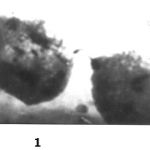 |
Figure 1
|
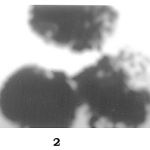 |
Figure 2
|
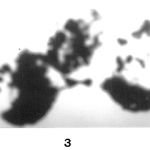 |
Figure 3
|
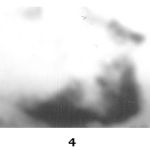 |
Figure 4
|
During diplotene, there are 8 bivalents (Fig. 5). The chromosome configuration is only of bivalents and no trivalents or multivalents are observed at any time.
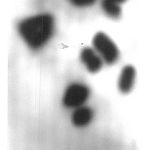 |
Figure 5
|
In Diakinesis, condensed bivalents of ring and rod type were found. In very rare cases two univalents were found (Raghuvanshi and Chauhan, 1969). There is a steady decrease in the chaisma frequency at diakinesis and metaphase I with an increase in the terminalization coefficient. The bivalents are condensed and well distributed in the cytoplasm. The terminalization is almost complete at metaphase I. Dnyansagar and Sudhakaran 1968 noted in Vinca rosea almost complete terminalization at the late diakinesis itself.
In C. roseus, there was usual orientation of the 16 chromosomes (Fig. 6) After this phase univalents moved to opposite poles. They moved to opposite poles probably due to precocious separation of bivalents. At anaphase I, the separation of chromosomes was regular i.e. 8 : 8 segregation without any anomaly (Fig. 7). Telephase I was normal as well. No laggard, strays or dividing univalents were observed. At the end of the microporogenesis, normal tetrads were observed (Fig. 8). The fertile pollen grains were deeply stained, full of cell content (Fig. 9) while sterile pollen grains are lightly stained, empty, transparent and shrunken.
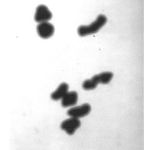 |
Figure 6
|
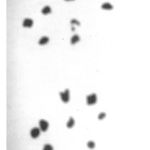 |
Figure 7
|
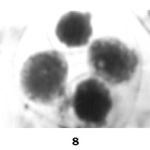 |
Figure 8
|
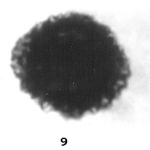 |
Figure 9
|
There is no marked variation among the plants of Catharanthus roseus collected from the different localities of Patna Therefore, it is inferred that the species is almost ecologically well established locally. Hence, desirable advantageous changes in the chemistry of the plant can be devised and accomplished through in vitro propagation method. As a resultant of exhaustive research work in the allied fields, two anticancer medicines derived from it, oncovin® and Velban® are already in the market but prohibitively expensive emphasizing further probing.
Figures : Meiotic details in C. roseus
(1) 2 PMCs having a chromatin positive connection between them.
(2) & (3) Migration of chromatin positive bodies from one to another PMCs.
(4) A PMC devoid of any chromatin positive body.
(5) Diplotene
(6) Metaphase I
(7) Anaphase I
(8) Tetrad
(9) A Fertile Pollen
Acknowledgement
One of the authors, Rachna Prasad greatfully acknowledge. Prof. (Dr.) U.K. Sinha for his able guidance during the preparation of the manuscript.
References
- Celarier R.P., 1956. Tertiary butyl alcohol dehydration of chromosome smears. Stain Tech. 31 : 155-157.
- Darlington C.D. and La Cour L.F., 1963 chromosome breakage and the nucleic acid cycle. J. Grenet 46 : 180-267.
- Gottschalk W., 1970. Chromosome and nucleus migration during microsporogenesis of Pisum sativum, Nucleus 13 : 1-9.
- Haroun S.A., 1995, Cytomixis in pollen mother cell of Polygonum tomentosum schrank, Cytologia 60 : 257-260.
- Singhal V.K., Gill B.S. and Dhariwal R.S., 2007. Status of chromosomal diversity in the hardwood tree species of Punjab state. J. Cyto. Genet. 8 : 67-83.
- Raghuvanshi S.S. and Chauhan A.K.S., 1969 Cytomorphological studies of artificially induced tetraploids of catharanthus roseus. Phyton Annales Rai Botancae 13 : 141-332.
- Dnyansagar V.R. and Sudhakaran I.V., 1968 Meiotic Studies in Vinca rosea Linn. Cytologia. Tokyo, 33 : 435-464.







